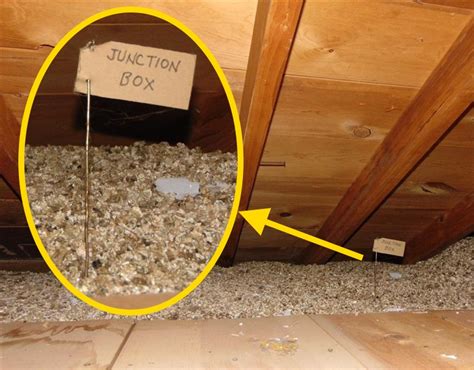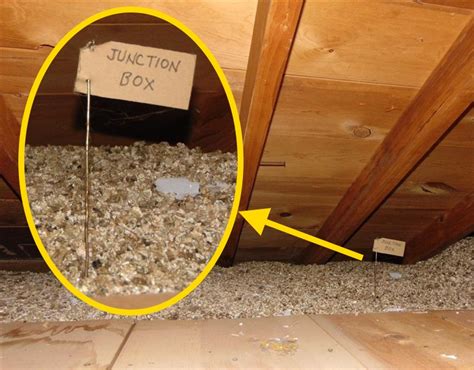can junction box be under plywood attic What Are The Rules For Junction Box In Attic? You can't conceal junction boxes in ceilings, walls or non-accessible attics and under-floor areas. In addition, they should not be placed in areas where flammable gases, vapors or dust are .
At the junction box, locate the main wire coming from the main breaker box and disconnect any wire nuts in place to reveal the copper ends of those wire. Locate the black/red (hot)wire and connect it using the wire twist locks to the black wire of your electrical wire to install.
0 · insulation for attic junction boxes
1 · covering attic junction boxes
2 · attic junction boxes illegal
3 · attic junction box wiring
4 · attic junction box rules
5 · attic junction box problems
6 · attic junction box pictures
7 · attic junction box not covered
Is it ok to have 2 romex cable coming out of the same hole on a junction box. Like pictured below? I'm also updating the switch and outlet near the basement door.
In most places, they put the connections in a junction box (I corrected one or places where connections (wire nuts) were just dangling in the air). But, in all cases the junction boxes are not covered and are not fastened . junction box itself is no issue. Covering it up is pushing it a bit. You would be removing part of the finish (insulation) to get to it. I think his main concern is not being able to . It is possible to install a junction box in an attic, but you’ll need to ensure that it is easily accessible. The junction box must be visible in the attic, otherwise, it could be forgotten about and potentially be dangerous. The box . Installing a junction box in the attic has certain requirements that must be met to ensure safety and compliance with electrical codes. Here are some fundamental considerations: Accessibility: The location of the junction .
Not a good design choice, but still legal. If possible, mount the box up high enough to be above any insulation. Washington state has an amendment saying they must be marked if .What Are The Rules For Junction Box In Attic? You can't conceal junction boxes in ceilings, walls or non-accessible attics and under-floor areas. In addition, they should not be placed in areas where flammable gases, vapors or dust are .
Would it be ok to cut out a plywood hatch around where the junction box would go? Is that considered accessible? My second idea was to use double gang switch boxes . The junction box is in the middle of the attic, where the vertical height from the attic floor to the roof/rafters is quite high (10+ ft). However, the junction box is next to a vertical .

silver metallic quilting fabric
It is against code to have a junction box that is not permanently accessible. Permanently accessible means, among other things, that you do not have to disassemble any . In most places, they put the connections in a junction box (I corrected one or places where connections (wire nuts) were just dangling in the air). But, in all cases the junction boxes are not covered and are not fastened to anything. The junction boxes that contain splices and are not accessible from the ceiling below should be exposed - not covered by insulation. If enough slack is present in the cables between the boxes, you may be able to raise them up a bit and mount them on trusses or other exposed framing members without having to run new wire. junction box itself is no issue. Covering it up is pushing it a bit. You would be removing part of the finish (insulation) to get to it. I think his main concern is not being able to locate it. Might ask him if he would go for 2x4 painted red sticking up saying junction box.
A: No, a junction box should not be completely covered by insulation. The junction box should remain accessible, which means it should not be closed in or blocked by insulation. Completely covering a junction box with insulation can create potential safety hazards and make it difficult to access the electrical connections inside if needed.It is possible to install a junction box in an attic, but you’ll need to ensure that it is easily accessible. The junction box must be visible in the attic, otherwise, it could be forgotten about and potentially be dangerous. The box can be mounted to the side of a joist, or onto its top edge. Installing a junction box in the attic has certain requirements that must be met to ensure safety and compliance with electrical codes. Here are some fundamental considerations: Accessibility: The location of the junction box should be easily accessible for future maintenance or . Not a good design choice, but still legal. If possible, mount the box up high enough to be above any insulation. Washington state has an amendment saying they must be marked if buried in insulation. So does "marking them" mean taking a sharpie to the cover and writing "junction box" on it and then burying it in insulation is acceptable?
What Are The Rules For Junction Box In Attic? You can't conceal junction boxes in ceilings, walls or non-accessible attics and under-floor areas. In addition, they should not be placed in areas where flammable gases, vapors or dust are present in an amount that could result in a fire or explosion. Furthermore It is important to cover an .
Would it be ok to cut out a plywood hatch around where the junction box would go? Is that considered accessible? My second idea was to use double gang switch boxes instead of junction boxes because I can mount them flush with the attic floor and just put a cover over it.
Yes, every box requires a cover plate. You can't have a cavity with individual wires and wirenuts enjoying a view of the attic. And a steel box needs a steel cover plate. In most places, they put the connections in a junction box (I corrected one or places where connections (wire nuts) were just dangling in the air). But, in all cases the junction boxes are not covered and are not fastened to anything. The junction boxes that contain splices and are not accessible from the ceiling below should be exposed - not covered by insulation. If enough slack is present in the cables between the boxes, you may be able to raise them up a bit and mount them on trusses or other exposed framing members without having to run new wire. junction box itself is no issue. Covering it up is pushing it a bit. You would be removing part of the finish (insulation) to get to it. I think his main concern is not being able to locate it. Might ask him if he would go for 2x4 painted red sticking up saying junction box.
A: No, a junction box should not be completely covered by insulation. The junction box should remain accessible, which means it should not be closed in or blocked by insulation. Completely covering a junction box with insulation can create potential safety hazards and make it difficult to access the electrical connections inside if needed.
It is possible to install a junction box in an attic, but you’ll need to ensure that it is easily accessible. The junction box must be visible in the attic, otherwise, it could be forgotten about and potentially be dangerous. The box can be mounted to the side of a joist, or onto its top edge. Installing a junction box in the attic has certain requirements that must be met to ensure safety and compliance with electrical codes. Here are some fundamental considerations: Accessibility: The location of the junction box should be easily accessible for future maintenance or . Not a good design choice, but still legal. If possible, mount the box up high enough to be above any insulation. Washington state has an amendment saying they must be marked if buried in insulation. So does "marking them" mean taking a sharpie to the cover and writing "junction box" on it and then burying it in insulation is acceptable?
What Are The Rules For Junction Box In Attic? You can't conceal junction boxes in ceilings, walls or non-accessible attics and under-floor areas. In addition, they should not be placed in areas where flammable gases, vapors or dust are present in an amount that could result in a fire or explosion. Furthermore It is important to cover an .
Would it be ok to cut out a plywood hatch around where the junction box would go? Is that considered accessible? My second idea was to use double gang switch boxes instead of junction boxes because I can mount them flush with the attic floor and just put a cover over it.
insulation for attic junction boxes

I brought the cable into the box using a duplex clamp and am left with wiring that is too short. What is the best and safest way to extend this wiring without having to go into the attic replace it completely?
can junction box be under plywood attic|attic junction box problems